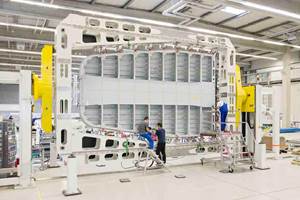Mississippi State opens Marvin B. Dow Stitched Composites Development Center
The new research center, built in partnership with Boeing, will work with stitched, resin-infused composites to advance composite materials for aerospace.
Mississippi State University (MSU; Starkville, Miss., U.S.) recently celebrated the opening of a new research center intended to help the university advance the fields of composite materials and aerospace.
MSU hosted a grand opening ceremony for the Marvin B. Dow Stitched Composites Development Center at the MSU Advanced Composites Institute on Friday, April 12. During the event, MSU President Mark E. Keenum noted that the university’s research and development activities, often carried out with government and industry partners, have a substantial impact on Mississippi’s economy, leading to the development of new companies and new jobs.
Boeing (Chicago, Ill., U.S.) selected MSU to create a stitched, resin-infused composites lab that will advance the development of composite structures technology. Through an agreement with the university, Boeing donated lab equipment and provided MSU researchers with additional resources to support the Advanced Composites Institute.
“This center matches so well for the vision that we have for the university in terms of strategic partnerships,” says David Shaw, MSU vice president for research and economic development. “Our best days for collaboration are definitely in our future, rather than in the rearview mirror.”
The center is named after pioneering NASA scientist Marvin B. Dow. While working at NASA Langley Research Center, Dow worked with McDonnell Douglas, which is now part of The Boeing Co., to develop advanced stitched composite designs and manufacturing methods. At the opening ceremony, MSU presented Dow’s daughter, Heather, with a plaque recognizing her father’s rich legacy in the field and his original vision to conduct stitched composites research that will revolutionize the way future aircraft are designed, built and flown.
“Marvin Dow’s ideas have been a game-changer,” says David E. Bowles, director of the NASA Langley Research Center in Hampton, Va., U.S. “When you look at composites today, they really have transformed the aerospace industry.”
Housed at MSU’s Raspet Flight Research Laboratory in Starkville, the Advanced Composites Institute continues the land-grant university’s legacy of innovation in aerospace and materials research and development. ACI is led by director Dennis Smith, head of the MSU Department of Chemistry. With a focus on applied inter-disciplinary research, the center has affiliated faculty members with expertise in chemistry and chemical, mechanical and aerospace engineering. The collaborative environment provides distinct opportunities for graduate and undergraduate students, and enables MSU to work with partners in government and industry to develop new knowledge in composites research and solve complex problems.
The Advanced Composites Institute is a member of the Federal Aviation Administration’s Joint Advanced Materials and Structures (JAMS) Center of Excellence. The center works to maintain a global leadership position in the field of composite materials science, engineering and manufacturing — including resin chemistry and infusion and stitched composites, followed by high temperature cure of large parts in ACI’s new state-of-the-art oven, which measures 50 feet by 20 feet by 10 feet. ACI supports economic development by boosting collaboration, technology transfer and entrepreneurship, in addition to serving as a workforce development and training center for strategic partners and suppliers.
“It’s an honor to have Mississippi State as part of our JAMS Center of Excellence, and we look forward to building on our relationship in the future,” says Ken Knopp, FAA manager of structures and propulsion research.
Raspet Flight Research Lab has served as an incubation space for multiple composite manufacturers that now have permanent Mississippi homes. The lab has served as an incubator for Mississippi-based manufacturing operations of several aerospace companies, including GE Aviation, Airbus Helicopters, Stark Aerospace and Aurora Flight Sciences, a Boeing Company.
Related Content
From the CW Archives: Airbus A400M cargo door
The inaugural CW From the Archives revisits Sara Black’s 2007 story on out-of-autoclave infusion used to fabricate the massive composite upper cargo door for the Airbus A400M military airlifter.
Read MoreSyensqo, Teijin Carbon achieve aerospace qualification for composite resin
Resin infusion system Prism EP2400 achieves NCAMP qualification with Teijin Carbon’s advanced NCF and UD reinforcements.
Read MoreComposite resins price change report
CW’s running summary of resin price change announcements from major material suppliers that serve the composites manufacturing industry.
Read MoreBladder-assisted compression molding derivative produces complex, autoclave-quality automotive parts
HP Composites’ AirPower technology enables high-rate CFRP roof production with 50% energy savings for the Maserati MC20.
Read MoreRead Next
Next-gen fan blades: Hybrid twin RTM, printed sensors, laser shock disassembly
MORPHO project demonstrates blade with 20% faster RTM cure cycle, uses AI-based monitoring for improved maintenance/life cycle management and proves laser shock disassembly for recycling.
Read MoreScaling up, optimizing the flax fiber composite camper
Greenlander’s Sherpa RV cab, which is largely constructed from flax fiber/bio-epoxy sandwich panels, nears commercial production readiness and next-generation scale-up.
Read MoreCeramic matrix composites: Faster, cheaper, higher temperature
New players proliferate, increasing CMC materials and manufacturing capacity, novel processes and automation to meet demand for higher part volumes and performance.
Read More.jpg;width=70;height=70;mode=crop)












